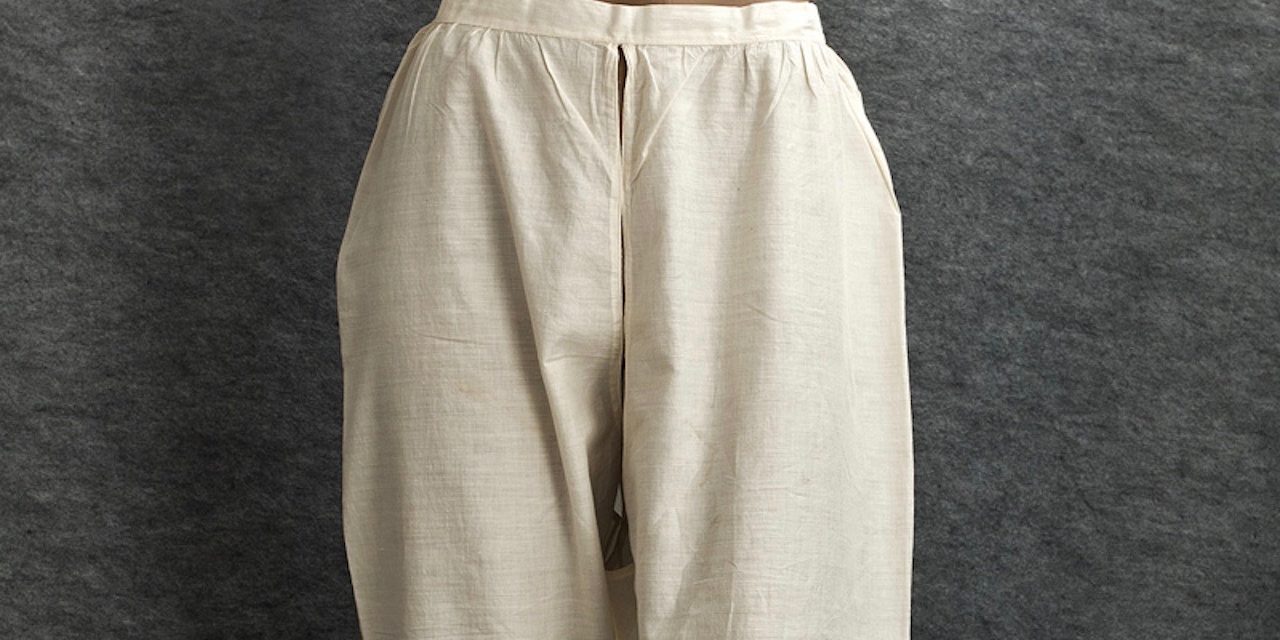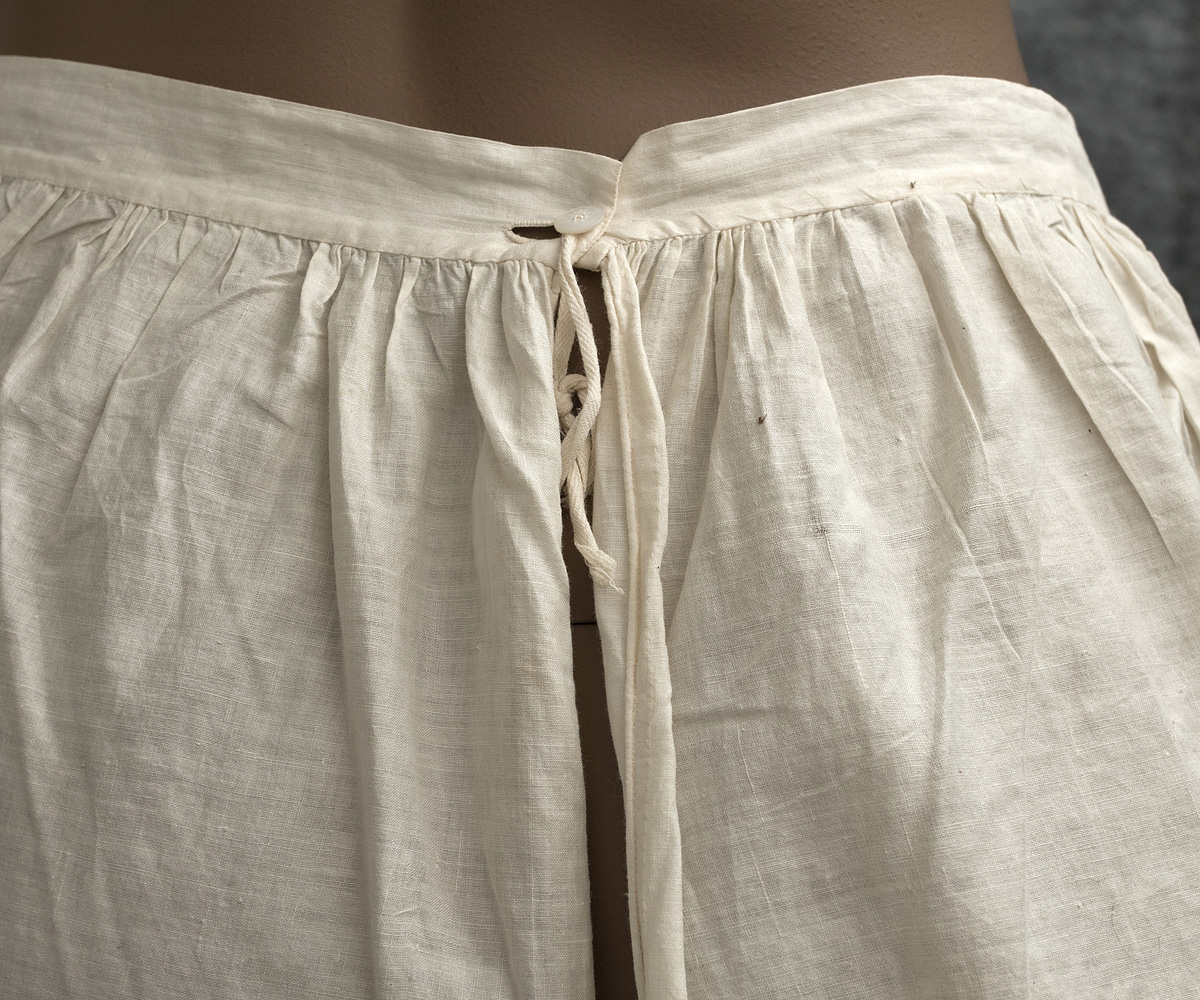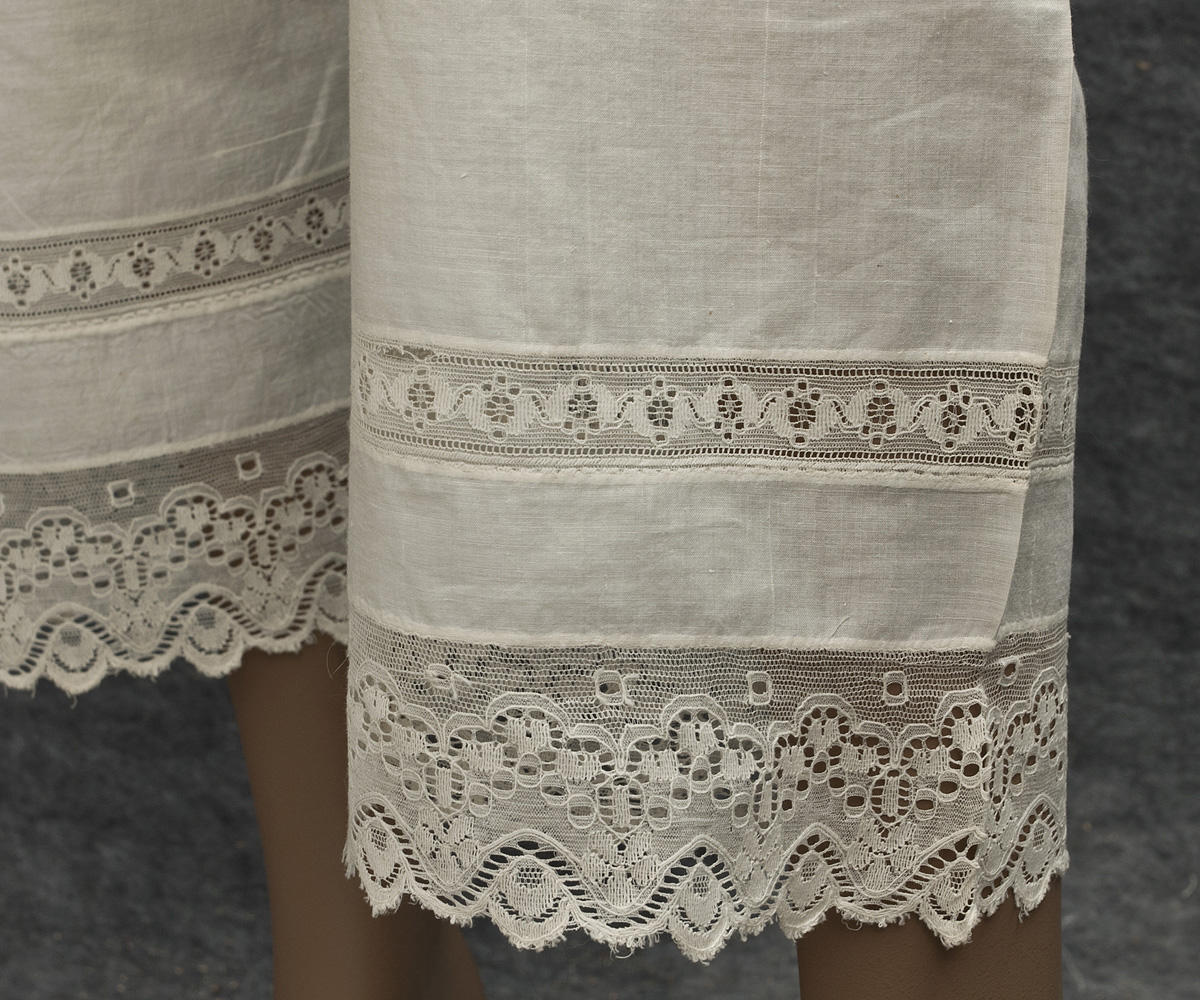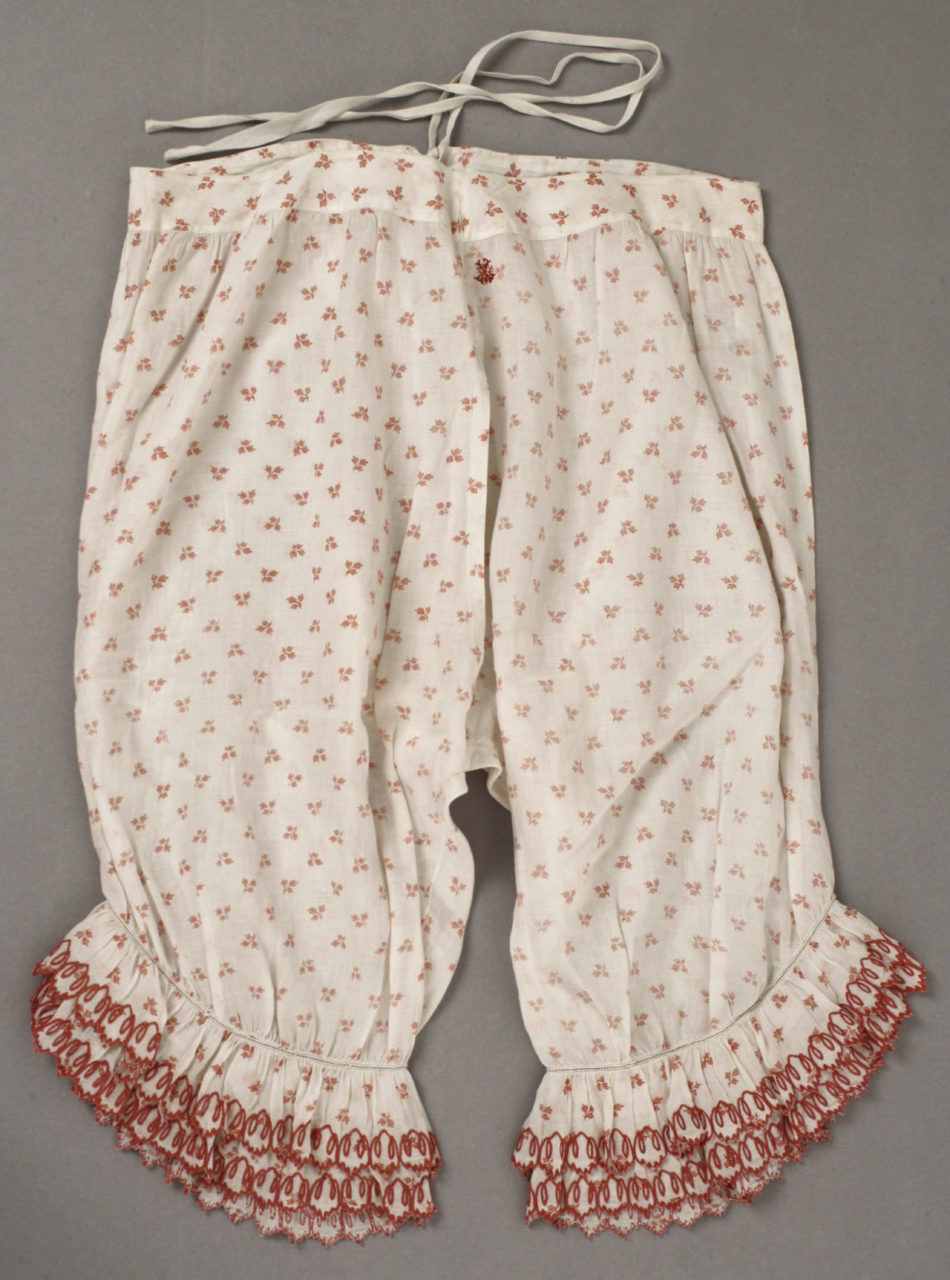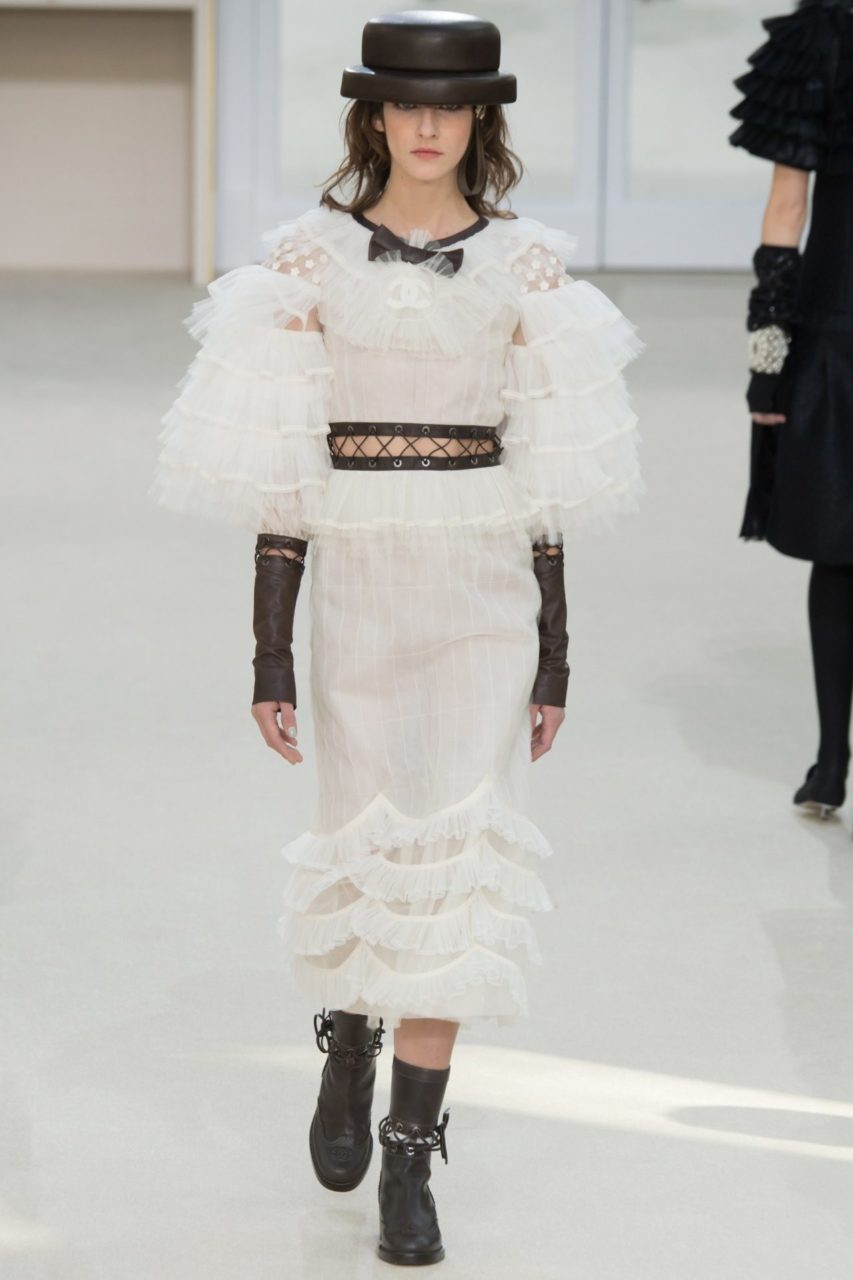Pantaloons (also referred to as pantalettes) are loose, pants-like undergarments that covered women’s lower halves in the late 18th and early 19th century.
The Details
As defined by Wikipedia, pantalettes (the female adapted version of pantaloons)–examples of which can be seen in figures 1-5–are:
“undergarments covering the legs worn by women, girls, and very young boys (before they were breeched) in the early- to mid-19th century.
Pantalettes originated in France in the early 19th century, and quickly spread to Britain and America. Pantalettes were a form of leggings or long drawers. They could be one-piece or two separate garments, one for each leg, attached at the waist with buttons or laces. The crotch was left open for hygiene reasons. They were most often of white linen fabric and could be decorated with tucks, lace, cutwork or broderie anglaise.
Ankle-length pantalettes for women were worn under the crinoline and hoop skirt to ensure that the legs were modestly covered should they become exposed. Pantalettes for children and young girls were mid-calf to ankle-length and were intended to show under their shorter skirts. Until the mid-19th century, very young boys were commonly dressed in dresses, gowns and pantalettes, though these were commonly associated with girls’ clothing, until the boys were breeched at any age between 2 and 8 years of age, and sometimes older. Young boys would be dressed in this fashion until at least they were toilet-trained.”
Doreen Yarwood in European Costume: 4000 Years of Fashion defines the pantaloon as a:
“Women’s undergarment in the nineteenth century. The word was also used for early nineteenth century men’s trousers which fastened with a front panel buttoned to the waistcoat with three buttons.” (284)
The term pantaloon was originally used to describe the undergarment, but as time went on it was shortened to pants and used more broadly to describe divided coverings of the legs.
Fig. 1 - Designer unknown. Woman's lace-trimmed pantalettes, 1820s. Source: Vintage Textile
Fig. 2 - Designer unknown. Woman's lace-trimmed pantalettes, 1820s. Source: Vintage Textile
Fig. 3 - Designer unknown. Woman's lace-trimmed pantalettes, 1820s. Source: Vintage Textile
Fig. 4 - Designer unknown (American or European). Pantalets, mid-19th century. Cotton. New York: The Metropolitan Museum of Art, 1999.503.2. Gift of Titi Halle, 1999. Source: The Metropolitan Museum of Art
Fig. 5 - Designer unknown (American). Pantalets, ca. 1830. Linen, cotton. New York: The Metropolitan Museum of Art, 1977.91.4. Purchase, Irene Lewisohn Bequest, 1977. Source: The Metropolitan Museum of Art
Philippe Perrot in an article on “Invisible Clothing” mentions the initial resistance to the undergarment:
“The spread of women’s pantaloons within the bourgeoisie – and eventually among workers and peasants – did not occur without resistance. Medical opinion was itself mixed. According to Casimir Daumas, ‘In our temperate climate there are women who habitually wear underpants as their first garment. This is a superfluity that is usually unrelated to the harshness of the climate…. However, beneath a vast, open, cold crinoline, underpants might be necessary.'”
Pantaloons and pantalettes, on women, also became more decorated with lace as the trend continued (Figs. 3, 5). It also became fashionable to have them showing at the bottom of the dress. An anecdote from Susan J. Vincent’s book The Anatomy of Fashion (2009) recounts how a stylish princess wore her pantalettes:
“By 1811 for instance, fifteen-year-old Princess Charlotte, the rather racy daughter of George IV and Queen Caroline, had adopted them. Lord Glenbervie, who had it from his wife who was present at the time, wrote that on one occasion in company with her mother, the princess was sitting with her legs stretched out, thus showing her drawers ‘which, it seems, she and most young women now wear’. Her governess, Lady de Clifford, felt it necessary to give Charlotte a hint:
‘My dear Princess Charlotte’, she said, ‘you shew your drawers.’
‘I never do, but where I can put myself at ease’, replied the princess.
Lady de Clifford persevered: ‘Yes, my dear, when you get in or out of a carriage.’
‘I don’t care if I do’, came the insouciant reply.
‘Your drawers are too long.’
‘I do not think so—the Duchess of Bedford’s are much longer, and they are bordered with Brussels lace.”
The need for women’s undergarments became apparent as the materials for dresses became more sheer. The pantaloons originally started out as tight fitting, but got more full and decorated (Fig. 4) as time went on and the trend evolved. They were also the first modern indication of women wearing pants.
Its Afterlife
The Fall 2015 and 2016 collections of many designers were Victorian-influenced with ruffles, lace trims, and pants and skirts that have clear influence from the original pantaloon. A 2016 dress from Chanel (Fig. 6) is reminiscent of the pantaloon, from its straight cut to the sheer white linen and detailed lace trims.
Fig. 6 - Chanel; Photograph by: Yannis Vlamos. Chanel Fall 2016 Ready-to-Wear, Fall 2016. Source: Vogue
References:
- “Pantalettes.” Wikipedia, June 25, 2017. https://en.wikipedia.org/w/index.php?title=Pantalettes&oldid=787469638.
- Perrot, Philippe. “Invisible Clothing.” In Classic and Modern Writings on Fashion. Oxford: Berg, 2009. Accessed October 07, 2016. https://www.bloomsburyfashioncentral.com/products/berg-fashion-library/book/classic-and-modern-writings-on-fashion/invisible-clothing.
- Vincent, Susan J. “Genitals and Legs.” In The Anatomy of Fashion: Dressing the Body from the Renaissance to Today, 97–132. Oxford: Berg, 2009. Accessed October 07, 2016. http://dx.doi.org/10.2752/9781847888617/ANAOFFASH0005.
- Yarwood, Doreen. European Costume: 4000 Years of Fashion. New York: Bonanza Books, 1982. http://www.worldcat.org/oclc/8171068.

